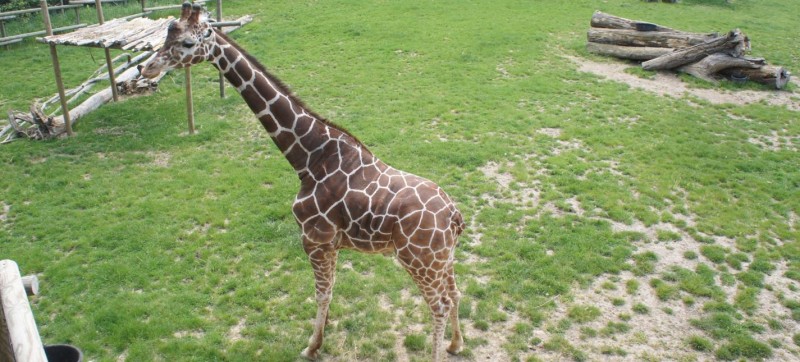Giraffe - Giraffa camelopardalis reticulata



Habitat:
Found in arid and dry savanna areas south of the Sahara wherever there are trees.
Range:
South of the Sahara Desert
Activity Cycle:
Diurnal
Features:
Both male and female giraffes have a spotted coat. The pattern of the coat varies and is an aide for camouflage with the different habitats. The nine giraffe subspecies have various skin patterns. The reticulated giraffe has the most distinctive patterns of the 8 subspecies. The coat has brown, regular box like patterns. The skin pattern for an individual giraffe is constant throughout the giraffe’s life. With the changing of season and health, the coat color may be altered.
Size:
Giraffes are the world’s tallest mammal. Male giraffes (bulls) stand around 18 feet tall and females stand up to 14 feet. Males can weigh up to 3000 pounds and females up to 1500 pounds.
Social Structure:
Giraffes are social animals, living in loose, open, unstable herds, with no specific leaders, varying from 10 to 20 individuals, although herds of up to 70 have been observed. Individual giraffes join and leave the herd at will. Herds can include all female, all male, female with young calves, or mixed genders and ages. Female giraffes are more social than male giraffes. Isolated individuals can also be encountered in the wild.
Life Expectancy:
15-20 years
Diet:
In the wild they eat various species of acacias. They also browse from the leaves and shoots of trees or shrubs of other species, but they are selective. At the zoo they eat alfalfa hay and pellets, apples, carrots, bananas and browse (elm and alder are favorites).
Reproduction:
Giraffes are polygynous. Bulls carefully guard an estrous female from other male giraffes. Courtship starts when a bull approaches a cow to perform a urine test, smelling the urine with a pronounced lip curl, a behavior referred to as flehmen. The bull will then proceed to rub his head near the rump of the female and rest it on her back. Male giraffes lick the tail of the female and lift his foreleg. If receptive, the female giraffe will circle the male, hold her tail out, and take on a mating position, after which copulation occurs. Conception occurs in the rainy season, with birth occurring in the dry months. Most giraffe births take place from May to August. Female giraffes breed every 20 to 30 months. The gestation period is between 14-16 months. The weaning period for males is 12 to 14 months. Female giraffes reach sexual maturity at 3 to 4 years of age but do not breed for at least another year. At age 4 to 5 years, male giraffe become sexually mature; however, it is not until seven years of age when they start to breed. Calves are about 6 feet tall when born and grow rapdily. As much as an inch a day! By 2 months they are eating leaves and by 6 months they are feeding independently.
Status:
Reticulated giraffes are listed as Endangered by the IUCN. Three other subspecies of giraffe are currently listed as Critically Endangered.
Interesting Facts:
- A giraffe’s heart can pump 16 gallons (61 l) of blood in one minute!
- Giraffes have the largest eyes of any land mammal!
- Other animals on the savanna (such as zebras, ostriches, antelopes) use giraffes as watchtowers or observation posts for predators!
- Giraffes have one of the highest blood pressures of all animals, due to their height and the large size of their heart. Because of this, their veins and arteries are much thicker compared to other large mammals!
- Giraffe necks contain 7 elongated vertebrae (up to 10 inches long each). Giraffes have a steeply sloping back from the shoulders to the rump.
- Giraffes feed and drink during the morning and evening. During the hot midday, giraffes usually chew their cud.
- Giraffes rest at night while standing up. When resting, the head lies on a hind leg, with the neck forming an impressive arch. Giraffes sleep standing up but can occasionally lie down. Giraffes that are resting lightly remain in a fully upright position, with half-closed eyes, and ears continuing to twitch.
- Giraffes are fast moving mammals, reaching speeds from 32 to 60 km/h (up to 35 mph). They can sprint for considerable distances.
- Giraffes are host to troublesome ticks. Oxpecker birds (Buphagus africanus) rests on the backs and necks of giraffes, removing the ticks from the giraffe skin. There is a mutually beneficial relationship between giraffes and oxpecker birds.
- Necks are 6 feet long and weigh approximately 600 pounds. Their legs are around 6 feet long. Their heart is 2 feet long and weighs about 25 pounds.
- They eat 75 pounds of food a day.
- Their tongue is 18 inches long and dark in color to prevent sunburn.
- The giraffe has an extremely high blood pressure (280/180 mm Hg) which is twice that found in humans. Additionally, the heart beats up to 170 times per minute double that of humans. It was previously thought that a giraffe had a really big heart, but recent research has revealed that there isn’t room in the body cavity for this. Instead, the giraffe has a relatively small heart and its power comes from a very strong beat as a result of the incredibly thick walls of the left ventricle.
- The horns on their head can be used for sparring among males.

AZA cooperatively manages this species as a Species Survival Plan® Program.
Video:
Prices
- Adult (13 and over)$12.50
- Child (2 - 12)$9.00
- Child (1 and Under)FREE
- Senior (65+)$11.50
- Active Military$11.50
We begin transferring animals to evening (off exhibit) holding at 4:30 each night.
Find Us
2320 N. Prospect Rd.
Peoria, IL 61603
Phone: 309-686-3365
Open Daily 10:00-5:00
Last admission at 4:30
